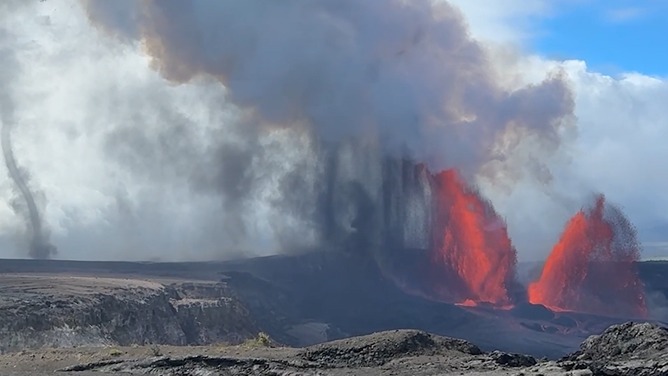
High in the escarpments of northern Australia, where sandstone cliffs catch the golden sun and rivers cut through monsoon forests, lies a place where the past lives not in silence, but in color. This is Kakadu—a landscape of vast ecological richness and even deeper cultural memory. And hidden within its caves and overhangs are paintings that whisper across time. They are not just art. They are ancestors.
One such painting, found in a rock shelter long protected by its natural dome, captures the eye immediately: a tall figure with arms outstretched, palms open, and a face that seems both human and beyond human. Around it dance smaller figures, some with radiant headdresses, others mid-movement. Their bodies are stretched and stylized, seemingly weightless—like spirits half-submerged in air.
This is Aboriginal rock art, part of one of the longest continuous artistic traditions in the world. The people who painted these images have lived on this continent for at least 65,000 years, making them the oldest living culture on Earth. The painting itself is thought to be in the range of 10,000 to 20,000 years old, depending on the layer and style. It belongs to what archaeologists refer to as the “Dynamic Figures” or “Gwion Gwion” tradition, known for its elegant, elongated forms and intricate detail.
But these classifications are modern, and somewhat crude. To the Aboriginal custodians of this land—the Bininj and Mungguy peoples—these are not just paintings. They are records. They are teachings. They are alive.
The central figure may represent a Mimih spirit—supernatural beings believed to live in the cracks of the rocks, thin as reeds and invisible to the eye unless they choose to reveal themselves. Mimihs are known as tricksters, but also teachers. They taught humans how to hunt, paint, dance, and navigate the land. Their presence in art is both a blessing and a warning: they are powerful, unpredictable, sacred.
Look closely, and you’ll see the raised arms are more than gesture—they are invocation. The figure seems to float, not merely stand, its fingers splayed like branches catching wind. The eyes are wide and circular, often interpreted as representing alertness or a state of vision beyond the physical. Some modern viewers, unfamiliar with Aboriginal mythology, have likened it to an extraterrestrial being, a kind of “ancient astronaut.” But such readings often miss the deeper truth: this figure is a connection between worlds, not an invader but a bridge.
The pigments used are natural—ochres made from iron-rich earth, applied with fingers, brushes made from grᴀss, or blown through hollow reeds. Remarkably, many of these paintings have lasted for tens of thousands of years, preserved by the rock’s chemical makeup and the overhangs’ protection from rain. Some were retouched over generations, as part of ritual renewal. Others were intentionally left to fade, returning to the stone from which they came.
Each element in the painting carries meaning. The headdresses, the postures, even the number of fingers or toes might refer to clan symbols, ceremonial roles, or Dreamtime stories. In Aboriginal culture, the Dreamtime (Tjukurpa) is not merely mythology—it is the living system of laws, origins, and ethics. It is the timeless present where past, future, and now coexist.
To stand before this rock wall is to be invited into that time. The silence of the cave is not empty. It vibrates with memory. You sense that every contour of the rock was chosen with intention—that the painter did not merely find a space to paint but listened to the stone, asking permission.
Many Aboriginal elders speak of the rocks as being alive. Not metaphorically, but truly. They breathe, remember, and communicate. The act of painting, then, was not one of creation but communion. The figures were already there, waiting. The hand simply brought them forward.
In a world increasingly divorced from nature, such a worldview feels radical—but perhaps it is our forgetting that is radical. These paintings remind us that art was once survival, that memory was once embedded in place. And they challenge us: can we see the world as animate again?
Of course, the history of this art is not untouched by violence. Since European colonization in the late 18th century, countless Aboriginal sacred sites have been destroyed, looted, or misinterpreted. Even today, some rock shelters are threatened by mining, vandalism, or climate change. And yet, the art endures—not just physically, but spiritually.
Communities continue to return to these places. Young people are taught to repaint or protect the sites, learning stories that go back 2,000 generations. Scientists work with elders to document the sites, translating knowledge without stripping it of its sacredness. It is a fragile collaboration, but a necessary one.
What makes this particular painting so striking is its paradox: it is both alien and familiar. Its form is ancient, yet it speaks with an urgency that feels modern. It looks like a dance, a prayer, a warning, an embrace. It reaches across time not with words but with presence.
We may never know the exact story behind this wall. Was it a ritual of summoning? A celebration of birth or rain? A record of mythic teaching? But perhaps the point is not to decode it but to sit with it, to let its mystery do what all great art does—open a doorway.
So the next time you pᴀss a rock, consider what it remembers. Imagine what it might have seen. The figure with outstretched arms is not just reaching up. It is reaching to us.
Will we reach back?
<ʙuттon class="text-token-text-secondary hover:bg-token-bg-secondary rounded-lg" aria-label="Chia sẻ" aria-selected="false" data-state="closed">


